UAF’s GINA Provides a Guiding Hand in Arctic Ocean Research
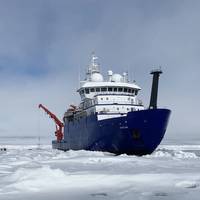
The research vessel Sikuliaq navigated among and around the chunks and slabs of Arctic sea ice above Alaska for several weeks on two voyages this fall, breaking through frozen slabs when it had to, just as its sturdy hull is designed to do. It's now on a third trip.The Sikuliaq, a 261-ft. ice-capable research vessel operated by UAF, pauses in the Arctic Ocean in June 2021 during its fifth year of operation. A few months later, it traveled farther north than ever before — almost 500 miles beyond Point Barrow.Satellite imagery produced at the Geographic Information Network of Alaska…
Rapp Marine to Equip New OSU Research Vessel
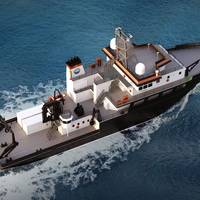
Rapp Marine said it has been selected by Gulf Island Shipyard, LLC, as the Overboard Handling System Single Source Vendor (OHS SSV) for Oregon State University’s (OSU) 193 ft x 41 ft multi-mission Regional Class Research Vessel (RCRV), with the option of two additional vessels. Funding for the RCRV project is provided by the National Science Foundation (NSF), and the contract design of the RCRV was developed by Glosten. The first vessel is currently under construction at Gulf Island Shipyard in Houma, La.
Innovative A-Frame Crane for RV Sikuliaq
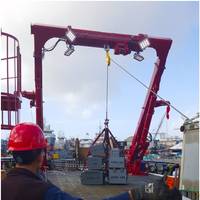
Recently installed aboard the R/V Sikuliaq was Allied Marine Crane’s innovatively redesigned A-Frame crane, which aims to improve the safety and capability of the marine research industry. Built at Allied Systems’ 250,000 sq. foot mfg. facility in Sherwood, Ore., the A-Frame was installed aboard 261-foot oceanographic research ship at the Bay Ship & Yacht Co. in Alameda, Calif. Delivery and installation was completed just about one year from the receipt of order. “We expect the A-Frame to do everything we designed it to do.
US Research Ships Ready to Cast Off in 2015
Two new U.S. research vessels are going full steam ahead: the U.S. National Science Foundation will formally commission its Arctic-bound Sikuliaq, and the Woods Hole Oceanographic Institution’s Neil Armstrong will begin science operations. Live Science reports that two new U.S. research ships will take to the seas in the Arctic and Atlantic in 2015, allowing scientists around the world to explore the geology, biology and health of the oceans. The ocean researchers said that the U.S. National Science Foundation has commissioned the Arctic research vessel Sikuliaq. The Woods Hole Oceanographic Institution's (WHOI) ship, dubbed Neil Armstrong, will begin science operations later.
RV Sikuliaq: Modern Electric Propulsion & Power Management
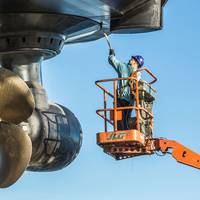
While ships have used electricity to help power vessels for a long time, new and sophisticated diesel-electric technologies are making serious gains in efficiency, noise and environmental impact, and is becoming the propulsion system of choice for some high profile names. A recent case is the diesel-electric powered, RV Sikuliaq (pronounced “see-koo-lee-auk,” an Inupiaq term meaning “young sea ice.”), a vessel embarking on a lifetime of studies in the polar sea region, including examining the effects of climate change and increased human presence in the Arctic.
MTU Powers Ice-Capable Research Vessel
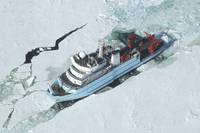
MTU, a Rolls-Royce brand, was chosen to power the Sikuliaq, a U.S. academic research vessel tailor-made for oceanographic research. The Sikuliaq, one of the most advanced university research vessels in the world, is owned by the National Science Foundation (NSF) and operated by the University of Alaska Fairbanks as a part of the University-National Oceanographic Laboratory System’s academic research fleet. The Sikuliaq is powered by a total of four MTU Series 4000 Ironmen engines, two of which are MTU 16V 4000 M23S marine generator engines.
House Subcommittee Hearing Highlights “Dismal State” of U.S. Icebreaking Capability

At the July 23, 2014, hearing of the House Subcommittee on Coast Guard and Maritime Transportation on “Implementing U.S. Policy in the Arctic” the committee chairman, Rep. Duncan Hunter (R-CA), opened the proceedings by holding up a graphic of the icebreaker fleets of the world—which depicts nearly 40 Russian icebreakers—and then commented on the “dismal state” of the U.S. icebreaker situation. The hearing background paper noted that the United States presently has only two working polar class icebreakers…
Coast Guard Medevac Injured Man from Motor Vessel
The U.S. Coast Guard conducted a medical evacuation, Monday morning, of an injured man aboard a motor vessel in the vicinity of Marinette, Wis. At about 8:45 a.m., the crew of Coast Guard Cutter Mobile Bay was notified via a shipboard radio of an injured man aboard the motor vessel Sikuliaq, a 254-foot U.S.-flagged research vessel, which the cutter's crew was escorting through the ice at the time. The vessel was 200 yards from the pier, and due to the Mobile Bay's superior maneuverability in the ice, the crew was able to break ice around the Sikuliaq before launching a small boat crew to tend to the injured man and take him to shore. The injured man was transferred to emergency medical services personnel and taken to the Bay Area Medical Facility in Marinette. uscgnews.com
Icebreaking Research Vessel to Transit Lake Michigan
The Coast Guard is alerting residents of ice-breaking activities scheduled to begin Tuesday and last into the weekend. The nearest towns to Pere Marquette Lake are Ludington and Scottville, Mich. The research vessel Sikuliaq is scheduled to transit through Pere Marquette Lake multiple times in order to gain access to Ludington's Occidental Chemical Facility, Feb. 18-22. The vessel has icebreaking capabilities. All ice fishermen should remove their ice shacks and equipment from these areas. Snowmobilers, all-terrain vehicle operators and other recreational users of the ice should plan their activities carefully, avoid shipping channels, and use caution near these areas of operation.
R/V Sikuliaq
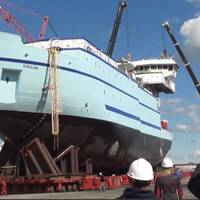
The 3,800-ton Alaska Region Research Vessel (ARRV) R/V Sikuliaq was launched on Oct. 13, 2012, at Marinette Marine in Marinette, Wis. Sikuliaq (pronounced see-KOO-lee-ack) will be operated by the University of Alaska Fairbanks (UAF) School of Fisheries and Ocean Sciences for the National Science Foundation as part of the University-National Oceanographic Laboratory System (UNOLS) fleet. The 261-foot global class ice-capable research vessel R/V Sikuliaq was designed by Glosten Associates. "R/V Sikuliaq is one of the most advanced research vessels in the world," said NSF Director Subra Suresh.
NSF Launch Arctic Research Vessel
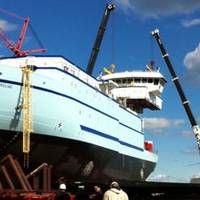
The National Science Foundation (NSF) announce launch of 'R/V Sikuliaq', a 'next-generation' global class research vessel. The NSC new-building project was in cooperation with the Marinette Marine Corporation (MMC) and the University of Alaska, Fairbanks (UAF). MMC is the Wisconsin shipyard that built the ship with funding provided by NSF through the American Recovery and Reinvestment Act. UAF's School of Fisheries and Ocean Sciences will operate the ship as part of the U.S. academic research fleet.
NSRP: U.S. Navy, Industry Partner for Research

Navy, Industry partner for research; sharing costs, risks, and rewards to reduce total ownership costs . America’s shipyards are fierce competitors, but they can also be close collaborators. The National Shipbuilding Research Program (NSRP) is a cooperative effort for American shipbuilders and the U.S. Navy, with the aim of improving efficiency and economy to reduce the cost of Navy ship construction and repair in American shipyards. According to the Navy’s NSRP program manager Connie Bowling of the Naval Sea Systems Command…
Keel-laying for R/V Sikuliaq
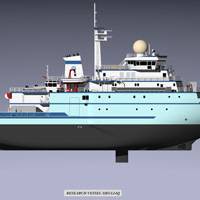
The University of Alaska Fairbanks and Marinette Marine Corporation held a keel-laying ceremony in April for the R/V Sikuliaq at Marinette Marine Corporation in Marinette, Wis. The 261-ft oceanographic research ship, formerly known as the Alaska Region Research Vessel, will be owned by the National Science Foundation and operated by UAF. The launch of the ship is scheduled for mid-2012 and the ship will be ready for full science operations in 2014. The Sikuliaq will be headquartered at the UAF Seward Marine Center in Seward, Alaska.





